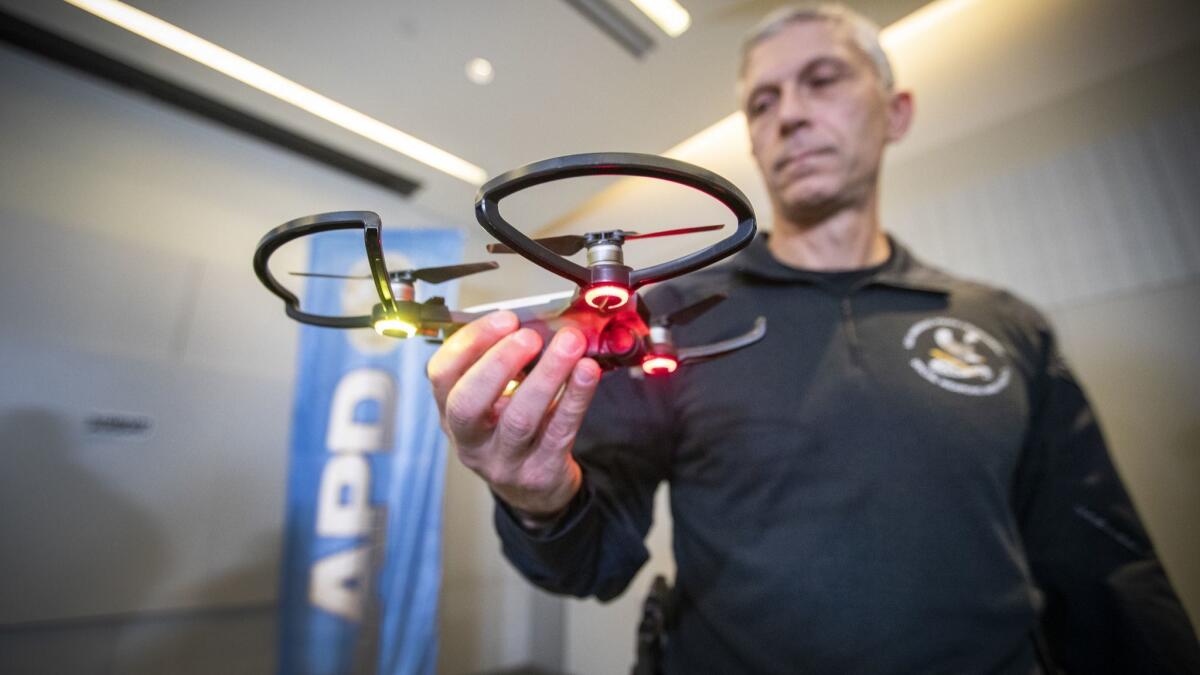LAPD deploys controversial drone for the first time

The SWAT officers thought the armed robbery suspect might be in a second-floor apartment.
To find out without risking their lives, they deployed a new tool: a small drone that hovered outside the window transmitting live video.
The video showed that the man did not appear to be in the room. The officers could enter knowing he was not behind the door waiting to ambush them.
The Jan. 9 standoff in Koreatown, which lasted nine hours before the suspect was safely arrested, was the first time the Los Angeles Police Department has used a drone, joining hundreds of law enforcement agencies across the country that have acquired them to provide a set of eyes in dangerous situations.
The LAPD’s drones are part of a pilot program approved in October 2017 by the five-member civilian Police Commission over the protests of residents and privacy activists concerned that the airborne, remote-controlled devices would be used to spy on them.
The department’s four drones vary in size and are no different from models commonly used by hobbyists.
A dozen SWAT officers were certified to fly them in July. The drones were deployed for the first time this month because of rules enacted by the Police Commission, limiting them to dangerous situations such as a barricaded suspect, active shooter or explosive device, said Police Commission President Steve Soboroff.
“It went over high hurdles to be utilized,” Soboroff said at a news conference Tuesday to announce the drone’s maiden voyage and unveil the video it captured.
LAPD Chief Michel Moore said that if used in “a responsible, thoughtful way,” drones can help keep both the public and police officers safe.
“It’s another set of eyes to help us understand the scenario and the challenges before officers and try to bring a situation to a peaceful resolution,” Moore said.

Officers used a small drone during a Jan. 9 standoff in Koreatown.
Other situations that may call for a drone, according to the rules, include hostage situations, natural disasters, hazardous-material incidents and search-and-rescue operations, as well as searches for suspects with “superior firepower,” “an extraordinary tactical advantage” or who are wanted for assaulting a police officer with a firearm.
The use of the drone must be approved by the deputy chief of the counter-terrorism bureau, and the police chief must be notified.
LAPD officials will submit reports documenting each drone operation to the Police Commission, which will evaluate the pilot program and decide on the future of drones at the LAPD in six months.
For some opponents of the program, any use of drones by law enforcement opens the door for abuse.
“The spin is on. The propaganda is on,” Hamid Khan of the Stop LAPD Spying Coalition said at a Police Commission meeting later Tuesday. “This is exactly what we spoke about: The mission creep has started.”
According to the Center for the Study of the Drone at Bard College, nearly 600 local law enforcement agencies, along with nearly 200 fire departments and 100 emergency management agencies, had drones in May 2018.
The study noted that the number of agencies with drones increased by 82% in 2017.
Dan Gettinger, the center’s co-director, said that large urban agencies like the LAPD have tended to be late adopters and use the drones differently than smaller agencies.
In rural or suburban areas, law enforcement commonly uses drones for search and rescue, disaster response or crime scene and accident photography, rather than standoffs with dangerous suspects, Gettinger said.
“Now we’re starting to see with the LAPD how they’re used in an urban environment,” he said. “It will be interesting to see how that plays out.”
Gettinger said he was not aware of any law enforcement agencies using drones in a way that raised privacy concerns.
San Marino Police Chief John Incontro said a drone would come in handy in his wealthy, suburban community. It could be used by police to see into gated backyards after burglaries, by firefighters to get a closer look at a blaze, and by public works officials to survey streets and sidewalks, he said.
The idea is in its infancy, Incontro said, and still has to be vetted by City Council members and residents.
Incontro remembers crawling up to a suspect while using a mirror to get a better view when he was an LAPD SWAT officer in the 1980s. As the captain of Metropolitan Division, which oversees SWAT, from 2010 to 2013, Incontro discussed drones with colleagues, but they were too expensive at the time to be practical.
“The way the department used it is very positive for law enforcement, and I’m very glad to see it,” Incontro said of the LAPD’s first drone deployment.
The Jan. 9 incident began about 5:45 a.m. when Metropolitan Division officers approached an apartment building in the 300 block of North Berendo Street looking for Shaka Hakeen Jones, 25, a suspect in an armed robbery last month.
After the officers determined that Jones was probably holed up in the building, they called in a SWAT team.
A suspect in an upper-story apartment is especially dangerous, because he has a sweeping view of officers approaching from below. They could have dangled a camera to see inside the window, but they would have been exposed while installing it.
The drone, a DJI Spark, captured a cluster of SWAT officers standing on a lower balcony as it flew toward the window. An unkempt kitchen and a sofa were visible, but glare from the glass made it difficult to see inside.
An officer eventually shot a projectile to break the window. The drone scanned the room, revealing that there was no one behind the door. That allowed officers on the other side to break in, confident that Jones was not lying in wait. They then used a robot to make sure no one was hiding in the apartment.
“It makes us safer, to be able to see something where we would have had to expose ourselves,” said SWAT Officer Steve Hernandez, who helped to guide the drone.
Officers eventually spotted hand prints leading to the attic. They used GoPro cameras to pinpoint Jones’ location, and he surrendered. Prosecutors have not yet filed charges against him.
For more news on the Los Angeles Police Department, follow me on Twitter: @cindychangLA
More to Read
Sign up for Essential California
The most important California stories and recommendations in your inbox every morning.
You may occasionally receive promotional content from the Los Angeles Times.











